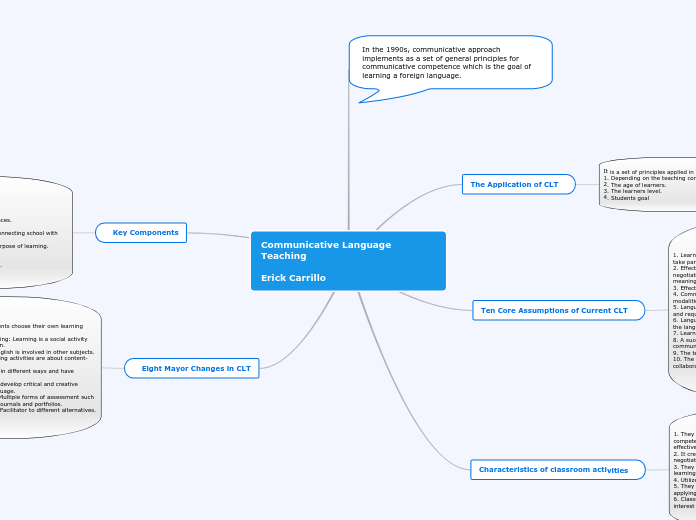Communicative Language Teaching
Erick Carrillo
In the 1990s, communicative approach implements as a set of general principles for communicative competence which is the goal of learning a foreign language.
The Application of CLT
It is a set of principles applied in different ways:
1. Depending on the teaching context.
2. The age of learners.
3. The learners level.
4. Students goal
Ten Core Assumptions of Current CLT
1. Learning a second language is easier when students are to take part in interaction
2. Effective exercise provide opportunities for students to negotiate meaning, expand language, how to use it and meaningful personal exchange.
3. Effective communication gives students processing.
4. Communication requires several language skills or modalities.
5. Language learning is aided by activities that are inductive and requiere to discover.
6. Language Learning is a process that demand creative use of the language and to commit errors.
7. Learners create their own way to learn a language.
8. A successful language learning includes good communication strategies.
9. The teacher is a facilitator.
10. The classroom is a place where students learn with collaboration and sharing.
Characteristics of classroom activities
1. They have the aim to expand the communicative competence of the students in order to communicate effectively.
2. It creates a demand for communication, interaction and negotiation.
3. They provide opportunities for inductive and deductive learning of grammar.
4. Utilize content to connect students lives.
5. They permit stuednts to personalize thier learning by applying what they have learned.
6. Classroom materials that are used are texts to produce interest and great teaching model.
Key Components
1. Focus on being learner-centered.
2. Focus on process oriented.
3. Focus on social learning
4. Focus on study of individual differences.
5. Focus on internal
6. Emphasize on holistic learning by connecting school with the real world.
7. Helping students understand the purpose of learning.
8. Focus on a whole approach.
9. Emphasize on the meaning of drills.
10. Focus on life-long learning process.
Eight Mayor Changes in CLT
1. Learner Autonomy: Students choose their own learning content and process.
2. The social nature of learning: Learning is a social activity which depends on interaction.
3. Curricular Integration: English is involved in other subjects.
4. Focus on meaning: Learning activities are about content- based teaching.
5. Diversity: Students learn in different ways and have different strengths.
6. Thinking Skills: Students develop critical and creative thinking to apply in the language.
7. Alternative Assessment: Multiple forms of assessment such as observation, interviews, journals and portfolios.
8. Teachers as Co-learners: Facilitator to different alternatives.
